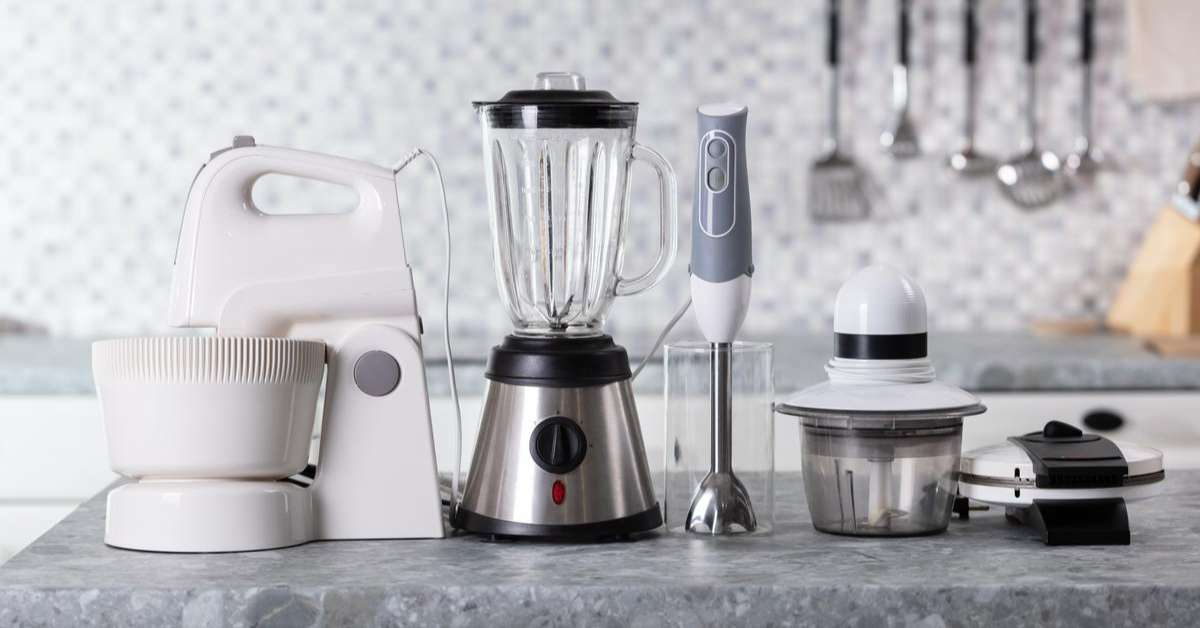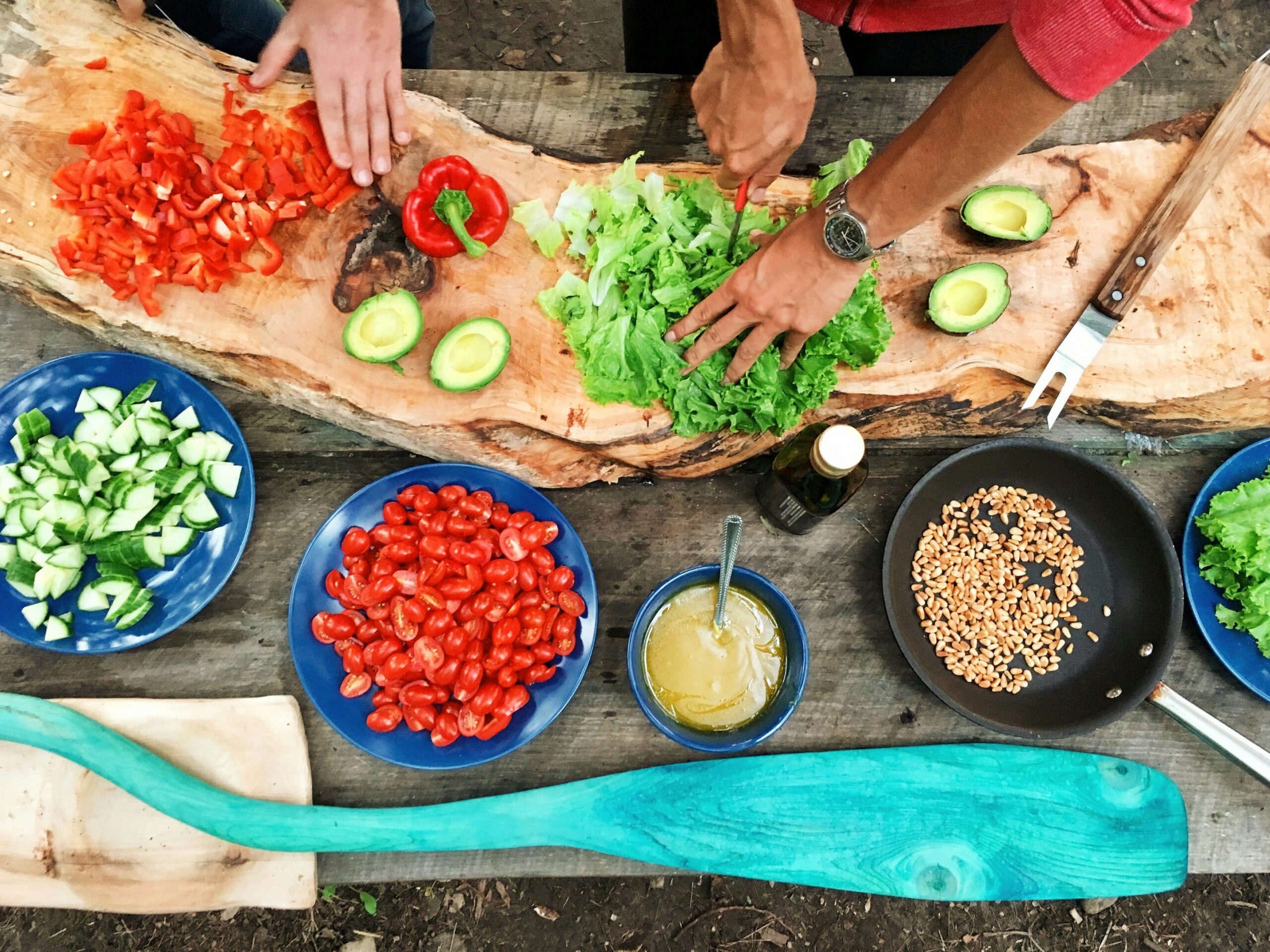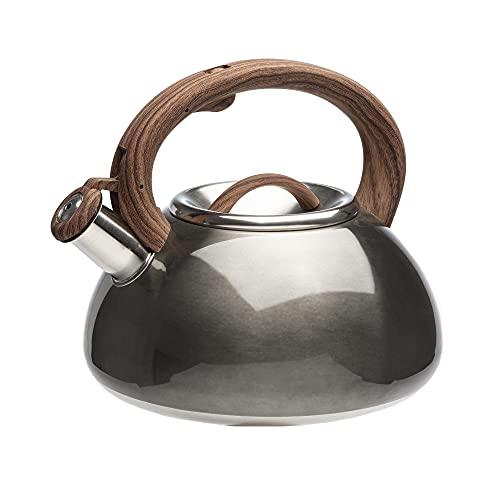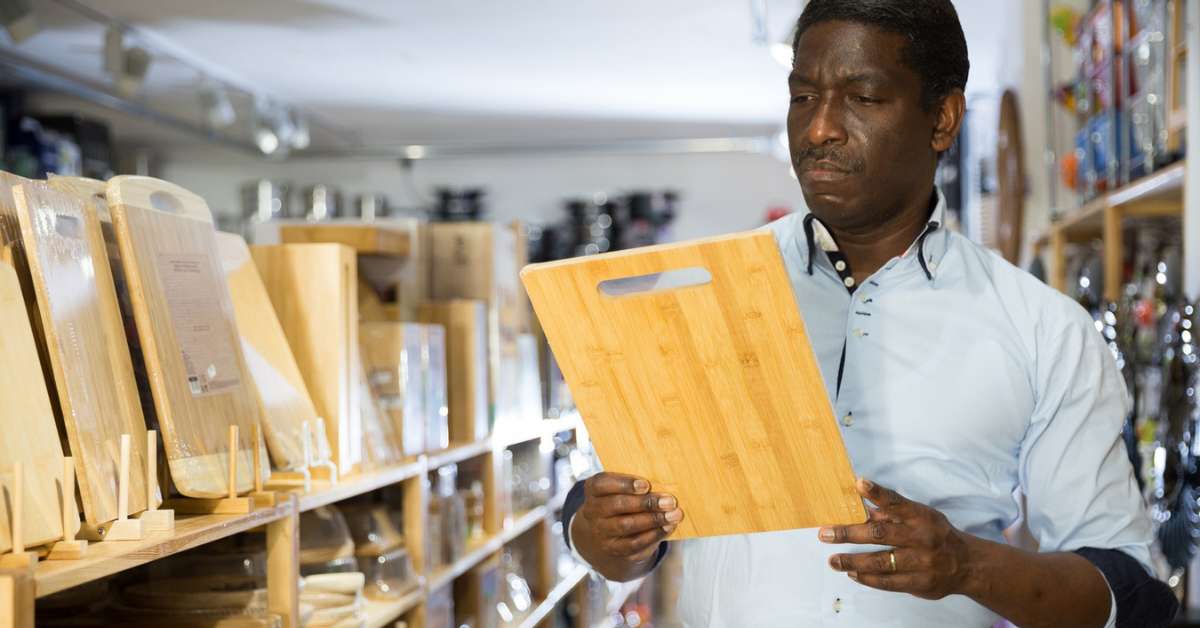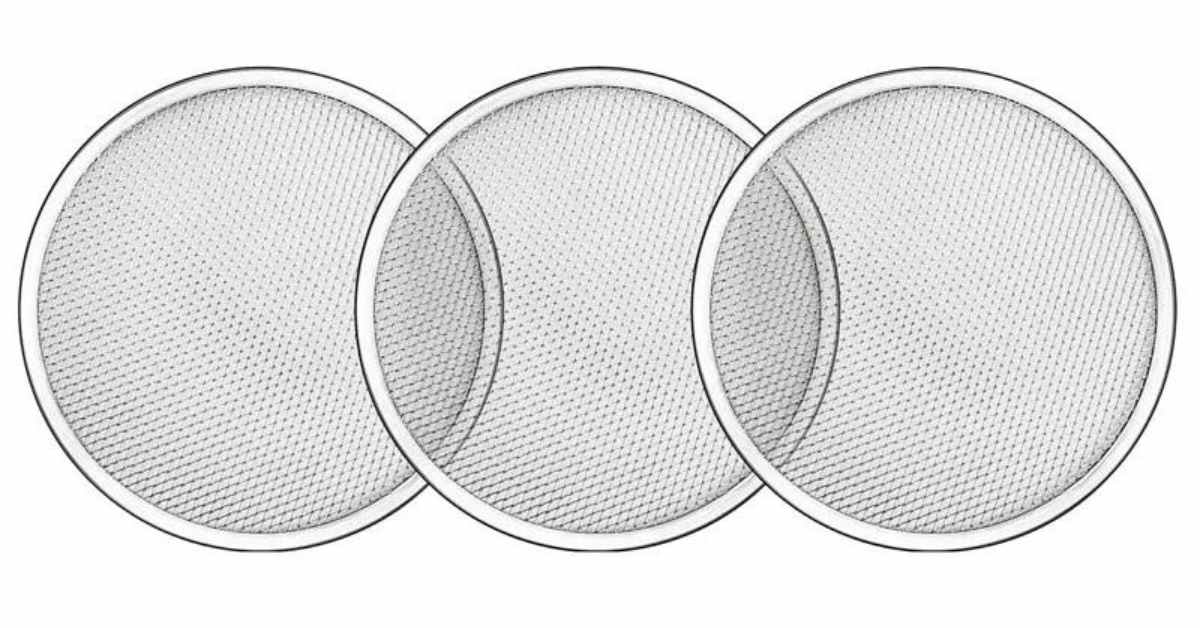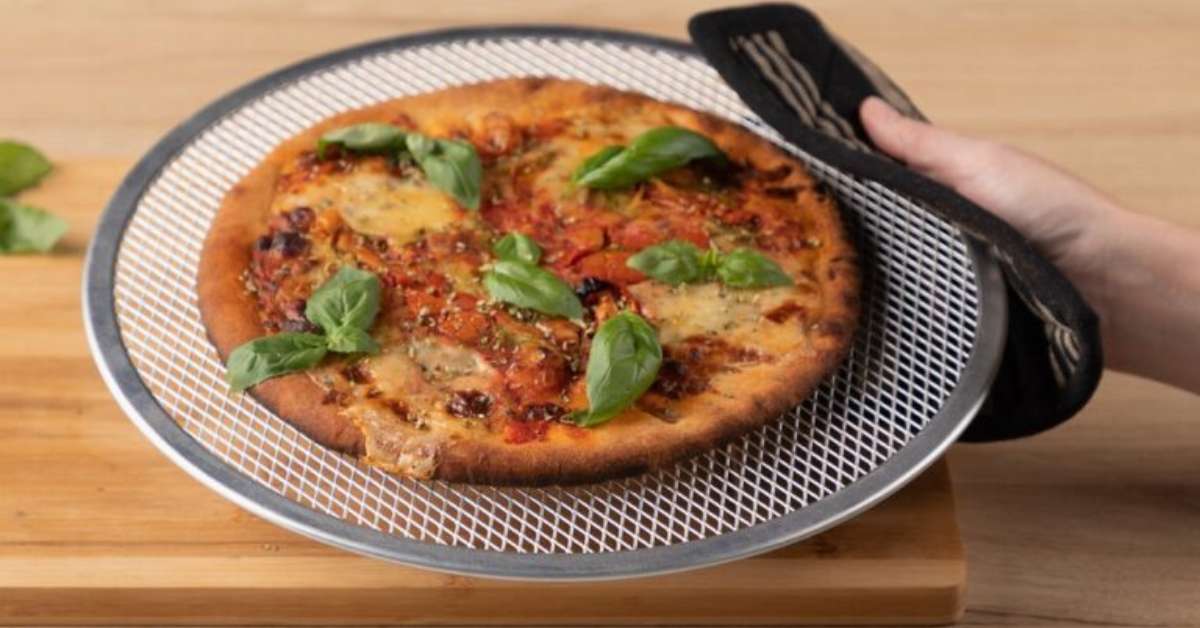In today’s fast-paced world, immersion blenders have become essential in every kitchen. However, alternatives are always good, especially when you want to explore different blending techniques or when your trusty immersion blender is unavailable.
This comprehensive guide will introduce you to the top 10 immersion blender alternatives that meet your blending needs and take your culinary adventures to new heights. Whether you’re a professional chef or a passionate home cook, these alternatives offer versatility, convenience, and exceptional blending performance. So let’s dive in and discover the best immersion blender alternatives that deserve a spot in your kitchen!
Table of Contents
ToggleWhat is an Immersion Blender
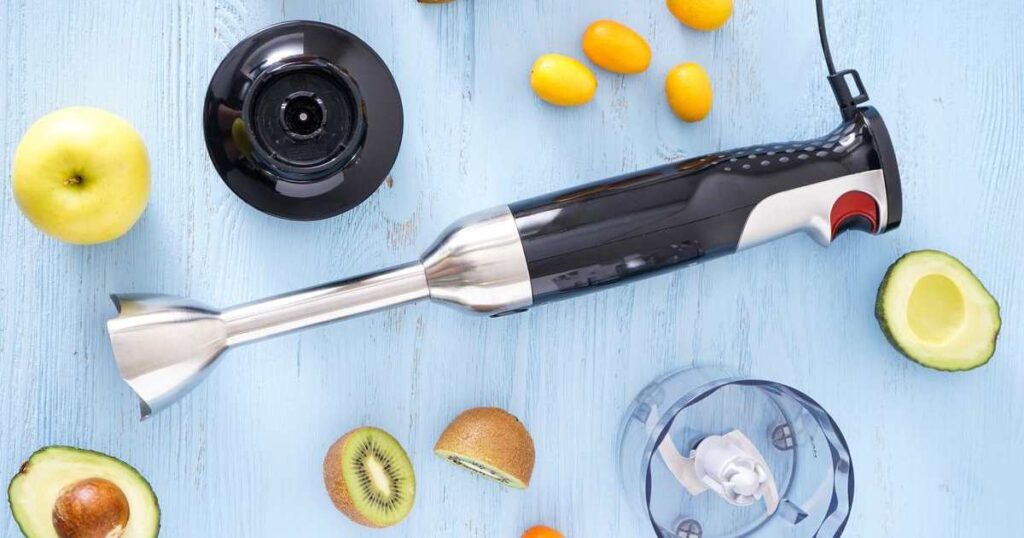
An immersion blender, a hand blender, or a stick blender is a versatile kitchen tool that allows you to blend ingredients directly in a container without transferring them to a separate blender. It comprises a handheld motorized unit with a blending shaft and blades at one end. This compact and easy-to-use device is designed for convenience and efficiency.
The immersion blender’s long, slender design makes it perfect for reaching into pots, bowls, or pitchers to blend soups, sauces, smoothies, and other liquid-based recipes. Its powerful motor and sharp blades swiftly blend and emulsify ingredients, creating a smooth and consistent texture.
One of the main advantages of an immersion blender is its portability and space-saving nature.
Unlike traditional countertop blenders, immersion blenders are compact and easily stored in a drawer or hung on a wall. They are also easy to clean, as the detachable blending shaft can be quickly rinsed or washed separately.
Whether you’re a professional chef in a busy restaurant or a home cook looking for a convenient blending solution, an immersion blender can be your go-to kitchen companion. Now that we understand what an immersion blender is let’s explore some excellent alternatives that offer similar functionality and performance.
Immersion Blender Alternatives
While immersion blenders are a fantastic kitchen tool, having alternatives is always good. Whether you’re looking for a different blending technique or your immersion blender is temporarily unavailable, these alternatives can step in and deliver exceptional results. Let’s explore the top 10 alternatives that can be excellent substitutes for an immersion blender.
Hand Mixer
A hand mixer is a versatile kitchen tool that can be an alternative to an immersion blender. While its primary function is mixing ingredients, it can also be used for light blending tasks. Here are some critical details about the hand mixer and how it can be an excellent immersion blender alternative:
Features:
- Compact and handheld design.
- Multiple speed settings for different mixing and blending needs.
- Detachable beaters or attachments for easy cleaning.
- Lightweight and easy to maneuver.
Benefits:
Mixing Versatility: A hand mixer excels at mixing ingredients for batters, doughs, and creams. It can incorporate air into recipes, making them light and fluffy.
Light Blending: While less potent than an immersion blender, a hand mixer can handle light blending tasks such as combining soups or sauces, especially if you prefer a chunkier texture.
Convenience: Hand mixers are portable and don’t require a separate container for blending. They are easy to handle and can be stored in a drawer, taking up minimal space in your kitchen.
Easy to Clean: Most hand mixers come with detachable beaters or attachments that can be quickly cleaned by hand or in the dishwasher, making cleanup a breeze.
Use Cases:
- Mixing cake batters, cookie doughs, and pancake batters.
- Whipping creams, eggs, and frostings.
- Incorporating air into meringues and mousses.
- Lightly blending soups, sauces, and dressings for a chunky texture.
While a hand mixer may not offer the same blending power as an immersion blender, it can still be a handy tool in your kitchen for various mixing and light blending tasks. In the next section, we will explore another alternative, the countertop blender, which provides more blending capabilities for larger quantities of ingredients.
Countertop Blender
A countertop blender is a powerful alternative to an immersion blender when blending more prominent ingredients or achieving smoother textures. Let’s delve into the details of the countertop blender and understand how it can be a valuable addition to your kitchen:
Features:
- Large, pitcher-like container with a lid and blades at the base.
- High-powered motor for efficient blending.
- Variable speed settings and pre-programmed functions.
- Some models may offer additional features like pulse function, ice-crushing capability, or smoothie settings.
Benefits:
Blending Power: Countertop blenders are designed for high-performance blending. They can handle various ingredients, from fruits and vegetables to ice and frozen ingredients, resulting in smooth and creamy textures.
Capacity: With a larger pitcher capacity, countertop blenders are ideal for preparing recipes in larger quantities, making them suitable for family meals, entertaining guests, or batch cooking.
Versatility: Countertop blenders can handle various tasks beyond blending, such as pureeing, emulsifying, grinding, and even making nut butter or dough depending on the model’s capabilities.
Multiple Speed Options: Most countertop blenders offer various speed settings to adjust the blending intensity according to your recipe requirements, giving you more control over the blending process.
Use Cases:
- Blending smoothies, milkshakes, and frozen drinks.
- Pureeing soups, sauces, and baby food.
- Creating creamy dips, dressings, and spreads.
- Grinding coffee beans, nuts, or spices.
- Making crushed ice for refreshing beverages.
- Preparing batter for pancakes, crepes, or waffles.
A countertop blender is a versatile and powerful alternative to an immersion blender, particularly when blending more significant ingredients or achieving smoother textures. In the next section, we will explore another alternative, the food processor, which offers a range of functions beyond blending.
Food Processor
Regarding versatility in the kitchen, a food processor is an excellent immersion blender alternative. With its diverse functions, the food processor can handle various tasks beyond blending. Let’s explore the details of the food processor and understand how it can enhance your culinary experience:
Features:
- Bowl-shaped container with a lid and multiple interchangeable blades and discs.
- High-powered motor for efficient processing.
- Variable speed settings and pulse function.
- Different attachments for slicing, shredding, chopping, pureeing, and blending.
Benefits:
Multifunctional: Food processors are designed to perform various kitchen tasks, making them an all-in-one solution. Along with blending, they can chop, shred, slice, grate, puree, and even knead dough.
Processing Power: The powerful motor and sharp blades of a food processor can handle more challenging ingredients, such as nuts, seeds, and dense vegetables, for efficient processing and blending.
Capacity: Food processors come in various sizes, allowing you to choose one that suits your needs. They can process more prominent ingredients, making them ideal for meal prep or cooking for a larger group.
Precision and Control: Food processors offer precise control over the processing time, speed, and consistency. Depending on the blades or discs used, you can achieve a coarse or fine texture.
Use Cases:
- Chopping vegetables, herbs, and nuts.
- Shredding cheese, carrots, or cabbage.
- Slicing cucumbers, potatoes, or onions.
- Pureeing soups, sauces, and dips.
- Grinding spices, grains, or coffee beans.
- Kneading dough for bread or pastry.
With its versatility and ability to handle various food preparation tasks, a food processor is an excellent alternative to an immersion blender. It offers more than just blending, making it a valuable tool in any kitchen. In the next section, we will explore another alternative, the stand mixer with a blender attachment, which combines blending capabilities with the functionality of a stand mixer.
Stand Mixer
The stand mixer with a blender attachment is a versatile kitchen appliance that combines the functionalities of a stand mixer and a blender. Let’s explore the details of the stand mixer and understand how it can serve as an excellent alternative to an immersion blender:
Features:
- Stand mixer with a base unit and a mixing bowl.
- Various speed settings and attachments for mixing, whisking, and kneading.
- Blender attachment with a pitcher-like container, lid, and blades.
- Some models may offer additional features like planetary mixing action or digital controls.
Benefits:
Blending and Mixing: The stand mixer with a blender attachment allows you to blend and mix ingredients in one appliance. It offers the blending capabilities of an immersion blender and a stand mixer’s mixing functionalities.
Large Capacity: The mixing bowl of a stand mixer can typically accommodate more significant quantities of ingredients, making it suitable for baking tasks that require mixing dough, batter, or frosting.
Precise Mixing Control: Stand mixers offer precise speed control, allowing you to mix ingredients at different speeds and achieve the desired consistency. They are handy when working with dough or batters that require specific mixing techniques.
Versatility: Along with blending and mixing, stand mixers often come with various attachments for tasks like whisking, kneading, and even pasta making. This versatility makes them a valuable addition to any kitchen.
Use Cases:
- Blending smoothies, milkshakes, and sauces using the blender attachment.
- Mixing dough for bread, cookies, or cakes using the mixing bowl and attachments.
- Whisking egg whites, creams, or meringues using the whisk attachment.
- Kneading dough for bread or pasta using the dough hook attachment.
A stand mixer with a blender attachment provides the best of both worlds, combining the blending capabilities of an immersion blender with the mixing functionalities of a stand mixer. It offers versatility, large capacity, and precise control for blending and mixing needs. In the next section, we will explore another alternative, the bullet blender, which is compact, efficient, and perfect for single-serving blends.
NutriBullet
The NutriBullet, a bullet blender, is a compact, efficient immersion alternative perfect for single-serving blends. Let’s delve into the details of the NutriBullet and understand how it can enhance your blending experience:
Features:
- Compact design with a blending cup and a blade assembly.
- High-powered motor for efficient blending.
- Various cup sizes and interchangeable lids for convenience.
- Pulse function for precise control.
Benefits:
Portability: The compact size of the NutriBullet makes it highly portable. You can easily blend your ingredients and take your smoothie or shake on the go with the provided travel lids.
Single-Serving Blends: The NutriBullet is designed for single-serving blends, allowing you to prepare customized smoothies, protein shakes, or personal-sized portions of blended recipes.
Efficient Blending: With its powerful motor, the NutriBullet can effectively blend various ingredients, including fruits, vegetables, ice, and seeds, resulting in smooth and well-incorporated blends.
Quick and Easy Cleanup: The detachable blending cup and blade assembly are easy to clean. Rinse them or place them in the dishwasher for hassle-free cleanup.
Use Cases:
- Blending personalized smoothies and protein shakes.
- Creating nutritious and delicious salad dressings or sauces.
- Grinding nuts, seeds, or coffee beans.
- Making small batches of baby food or purees.
The NutriBullet is a convenient and efficient immersion blender alternative, perfect for those who prefer single-serving blends and value portability. Its compact size and powerful blending capabilities make it an excellent choice for on-the-go individuals or those looking to create personalized blends. In the next section, we will explore another alternative, using a Handheld Milk Frother.
Handheld Milk Frother
A handheld milk frother can be a simple yet effective alternative to an immersion blender for specific blending tasks, especially when creating frothy and creamy textures. Let’s explore the details of the handheld milk frother and understand its capabilities as an immersion blender alternative:
Features:
- Compact and handheld design.
- Whisk-like attachment or whisking wand.
- Battery-powered or rechargeable.
- Single-button operation for easy use.
Benefits:
Frothing Milk: The primary purpose of a handheld milk frother is to create frothy milk for beverages like lattes, cappuccinos, and hot chocolates. It efficiently incorporates air into the milk, creating a creamy and velvety texture.
Small Blending Tasks: While less potent than an immersion blender, a handheld milk frother can handle small blending tasks such as combining powdered ingredients, mixing dressings or sauces, and creating light mixtures.
Portability: The compact size of a handheld milk frother makes it highly portable. It can be easily stored in a drawer or taken on the go for travel or camping purposes.
Easy to Clean: Most handheld milk frothers have detachable whisk attachments that can be rinsed under running water or efficiently cleaned in a soapy solution. They are designed for quick and effortless cleanup.
Use Cases:
- Frothing milk for lattes, cappuccinos, and hot chocolates.
- Mixing powdered drinks or protein shakes.
- Blending dressings, sauces, or marinades.
- Creating light and airy batters or egg mixtures.
While a handheld milk frother is primarily designed for frothing milk, it can also easily handle small blending tasks. Its compact design, portability, and easy cleanup make it a convenient immersion blender alternative for specific blending needs. The following section will explore another alternative, the Electric Whisk.
Electric Whisk
An electric whisk, also known as an electric hand mixer, is a versatile kitchen tool that can be an alternative to an immersion blender for specific blending tasks. Let’s explore the details of the electric whisk and understand its capabilities as an immersion blender alternative:
Features:
- Handheld device with beaters or whisk attachments.
- Multiple speed settings for different mixing and blending needs.
- Compact and lightweight design.
- Some models may offer additional attachments like dough hooks or balloon whisks.
Benefits:
Mixing and Whisking: The primary function of an electric whisk is to mix and whisk ingredients. It can easily handle tasks such as beating eggs, whipping cream, and combining batters or doughs.
Speed and Control: Electric whisks offer multiple speed settings, allowing you to adjust the mixing intensity according to your recipe requirements. This gives you precise control over the blending process.
Compact and Portable: Electric whisks are compact and lightweight, making them easy to handle and store. They are also portable, making them suitable for travel or smaller kitchen spaces.
Easy to Clean: Most electric whisks come with detachable beaters or whisk attachments that can be quickly cleaned by hand or in the dishwasher. This makes cleanup a breeze.
Use Cases:
- Beating eggs and whipping cream.
- Mixing cake batters, pancake batters, and cookie doughs.
- Incorporating air into meringues and mousses.
- Whisking dressings, sauces, and frostings.
- Combining ingredients for light mixtures or sauces.
While an electric whisk may not offer the same blending capabilities as an immersion blender, it excels in mixing and whisking tasks. Its compact design, multiple speed settings, and easy cleanup make it a versatile alternative for specific blending needs in the kitchen. The following section will explore another alternative, the Mandoline Slicer.
Spiralizer
A spiralizer is a creative immersion blender alternative specializing in turning vegetables and fruits into spiral or noodle-like shapes. Let’s explore the details of the spiralizer and understand its capabilities:
Features:
- Handheld or countertop device with interchangeable blades.
- Different blade options for various spiralizing styles.
- Secure grip or suction base for stability during operation.
- Easy-to-clean components.
Benefits:
Vegetable Noodles: The spiralizer transforms vegetables like zucchini, carrots, or sweet potatoes into noodle shapes, providing a healthy and low-carb alternative to traditional pasta.
Creative Presentations: Spiralized vegetables can add visual appeal to your dishes, making them more enticing and exciting. They can be used in salads, stir-fries, or garnish.
Versatility: Spiralizers come with different blades that enable you to create various spiral shapes, from thin noodles to wider ribbons. This versatility opens up a range of culinary possibilities.
Quick and Easy: A spiralizer is a quick and efficient way to achieve uniform spiral shapes. It simplifies the process of incorporating more vegetables into your meals.
Use Cases:
- Creating zucchini noodles (“zoodles”) for a healthy pasta alternative.
- Making curly fries or potato ribbons.
- Preparing garnishes or decorations from fruits and vegetables.
- Adding texture and visual interest to salads or side dishes.
While a spiralizer may not offer the blending capabilities of an immersion blender, it provides a fun and creative way to incorporate more vegetables into your meals. Its ability to transform vegetables into spiral shapes opens up a new world of culinary possibilities. The following section will explore another alternative, the Coffee Grinder.
Coffee Grinder
A coffee grinder can serve as a surprising immersion blender alternative for specific grinding tasks, mainly when grinding spices, nuts, or seeds. Let’s explore the details of the coffee grinder and understand its capabilities:
Features:
- Electric or manual grinder specifically designed for grinding coffee beans.
- Different grind settings for various coarseness levels.
- A removable grinding chamber or hopper for easy cleaning.
- Some models may offer additional features like timed grinding or precise grind size adjustments.
Benefits:
Grinding Spices, Nuts, and Seeds: While coffee grinders are primarily used for grinding coffee beans, they can also be used to grind spices, nuts, and seeds. The powerful blades of the grinder can effectively pulverize these ingredients into fine or coarse textures.
Versatility: Coffee grinders with adjustable grind settings allow you to achieve the desired coarseness or fineness for different ingredients. This versatility makes them suitable for various recipes and flavor profiles.
Efficiency: Coffee grinders are designed to efficiently grind coffee beans, which translates to efficient grinding of other ingredients. They can save you time and effort compared to manual grinding methods.
Easy to Clean: Many coffee grinders have removable grinding chambers or hoppers that can be easily cleaned. This ensures that different flavors or aromas do not mix when grinding ingredients.
Use Cases:
- Grinding spices like whole peppercorns, cinnamon sticks, or cumin seeds.
- Grinding nuts like almonds, walnuts, or hazelnuts for baking or cooking.
- Grinding seeds like flaxseeds or chia seeds for adding to smoothies or recipes.
While a coffee grinder is primarily intended for grinding coffee beans, it can be a handy immersion blender alternative for specific grinding tasks in the kitchen. Its versatility, efficiency, and ease of use make it a valuable tool for grinding spices, nuts, and seeds. The following section will summarize the immersion blender alternatives discussed in this comprehensive guide.
Summary: Immersion Blender Alternatives
This comprehensive guide has explored various immersion blender alternatives catering to different kitchen blending needs. Let’s summarize the alternatives discussed:
Hand Mixer: Ideal for tasks like whipping, mixing, and combining ingredients for baking or cooking purposes. It offers versatility and precise control over the blending process.
Countertop Blender: A powerful option for blending more significant quantities of ingredients, making it suitable for smoothies, soups, sauces, and more.
Food Processor: Provides various functions, including chopping, slicing, grating, and pureeing. It is a multipurpose tool for various food preparation tasks.
Stand Mixer: Perfect for heavy-duty mixing and kneading tasks, particularly in baking. It offers convenience and efficiency for large batches and dough preparation.
NutriBullet: A compact and portable option for single-serving blends, suitable for smoothies, protein shakes, and grinding nuts or seeds.
Handheld Milk Frother: Specializes in creating frothy textures for beverages like lattes, cappuccinos, and hot chocolates. It is compact, portable, and easy to clean.
Electric Whisk: Versatile for mixing, whisking, and delicate blending tasks. It offers multiple speed settings and ease of use.
Mandoline Slicer: Provides precise and uniform slicing for vegetables, fruits, and cheeses. It is efficient and enhances the presentation of various dishes.
Spiralizer: Turns vegetables into spiral or noodle-like shapes, adding creativity and variety to your meals. It offers a healthy and low-carb alternative to pasta.
Coffee Grinder: Surprisingly effective for grinding spices, nuts, and seeds with adjustable grind settings for different coarseness levels.
Each of these alternatives has unique features, benefits, and use cases. You can choose the alternative that best suits your requirements depending on your specific blending needs. Exploring these immersion blender alternatives allows you to expand your culinary options and achieve desired textures and recipe results.
FAQs About Immersion Blender Alternatives
How do you blend without an immersion blender?
You can use a few alternative methods if you don’t have an immersion blender. One option is to use a regular blender or a food processor to achieve similar blending results. Another option is to manually mash or puree the ingredients using a fork, potato masher, or sieve.
Can I use a hand blender instead of an immersion blender?
Yes, a hand blender is the same as an immersion blender. The terms “hand blender” and “immersion blender” are often used interchangeably so that you can use a hand blender as a substitute for an immersion blender.
Do I need an immersion blender?
Whether you need an immersion blender depends on your cooking preferences and the types of recipes you frequently prepare. While an immersion blender offers convenience and versatility, many blending tasks can be accomplished using alternative tools like a regular blender, food processor, or even manual methods.
Can you substitute a food processor for an immersion blender?
A food processor can substitute an immersion blender for specific blending tasks. However, it’s important to note that a food processor has a different design and may need to be more efficient and suitable for tasks that require immersion or blending in a liquid.
How can I decide which immersion blender alternative is suitable for me?
To decide which immersion blender alternative suits you, consider your specific blending needs, the types of recipes you frequently prepare, and the features and benefits offered by each alternative. Assess versatility, convenience, ease of use, and cleaning requirements to determine which alternative best aligns with your preferences and culinary requirements.
Conclusion
In conclusion, numerous immersion blender alternatives are available that can fulfill various blending needs in the kitchen. Each alternative offers unique features and benefits, from hand mixers and countertop blenders to food processors. Additionally, options like stand mixers, NutriBullet, handheld milk frothers, electric whisks, mandoline slicers, spiralizers, and coffee grinders provide specific functions and versatility.
By exploring these alternatives, you can expand your culinary capabilities and achieve desired blending results. Consider your specific requirements, preferences, and the types of recipes you frequently prepare to determine which immersion blender alternative is the right choice for you.

